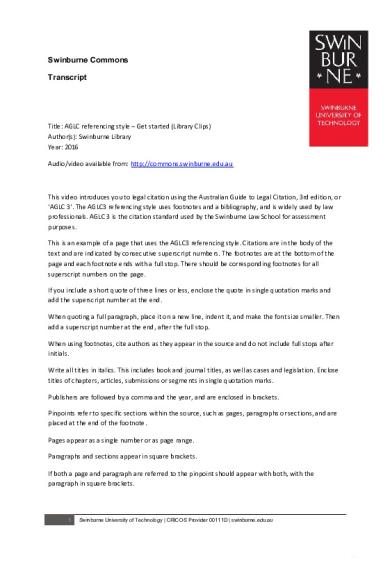AGCL3 PDF

| Title | AGCL3 |
|---|---|
| Author | Loan Hứa |
| Course | commercial law |
| Institution | Royal Melbourne Institute of Technology University Vietnam |
| Pages | 2 |
| File Size | 116 KB |
| File Type | |
| Total Downloads | 98 |
| Total Views | 125 |
Summary
Citation...
Description
Swinburne Commons Transcript
Title: AGLC referencing style – Get started (Library Clips) Author(s): Swinburne Library Year: 2016 Audio/video available from: http://commons.swinburne.edu.au
This video introduces you to legal citation using the Australian Guide to Legal Citation, 3rd edition, or 'AGLC 3'. The AGLC3 referencing style uses footnotes and a bibliography, and is widely used by law professionals. AGLC 3 is the citation standard used by the Swinburne Law School for assessment purposes. This is an example of a page that uses the AGLC3 referencing style. Citations are in the body of the text and are indicated by consecutive superscript numbers. The footnotes are at the bottom of the page and each footnote ends with a full stop. There should be corresponding footnotes for all superscript numbers on the page. If you include a short quote of three lines or less, enclose the quote in single quotation marks and add the superscript number at the end. When quoting a full paragraph, place it on a new line, indent it, and make the font size smaller. Then add a superscript number at the end, after the full stop. When using footnotes, cite authors as they appear in the source and do not include full stops after initials. Write all titles in italics. This includes book and journal titles, as well as cases and legislation. Enclose titles of chapters, articles, submissions or segments in single quotation marks. Publishers are followed by a comma and the year, and are enclosed in brackets. Pinpoints refer to specific sections within the source, such as pages, paragraphs or sections, and are placed at the end of the footnote. Pages appear as a single number or as page range. Paragraphs and sections appear in square brackets. If both a page and paragraph are referred to the pinpoint should appear with both, with the paragraph in square brackets.
1
Swinburne University of Technology | CRICOS Provider 00111D | swinburne.edu.au
If you cite a particular information source more than once on a page, you don’t include the same footnote multiple times. Instead, you use the terms ‘Ibid’ or ‘above n’. Ibid is used when you refer to a source in the immediately preceding footnote. In this example, footnote 19 comes from the same source and page as footnote 18. Footnote 20 also comes from the same source but it from different pages. ‘Above n’ is used when a source has previously been cited in a footnote, but it is not the immediately preceding one. In this example, the source in footnote 23 is the same as footnote 2 and this is indicated by using ‘above n’. Citations using ‘above n’ should appear with the author’s name, then the words ‘above n’, followed by the number of the footnote being referred to. ‘Above n’ should not be used for cases or legislation. A bibliography lists the sources you have included in your footnotes as well as any background sources you may have read but not actually cited in your paper. The bibliography is located at the end of the paper and can be divided into these 5 sections: Articles, books and reports, cases, legislation, treaties, and other. Citation rules for bibliographies are the same as for footnotes except for the following two differences. The first listed author’s name is inverted so that the surname is listed first, followed by a comma and then first name or initials. For works by two or more authors only the first authors name and surname should be inverted. Secondly, full stops do not follow citations in bibliographies. For more details on how to cite using the AGLC3 referencing style please to refer to the Library referencing pages. If you have any other questions about referencing, speak to a library staff member, visit the library website or contact us online.
2
Swinburne University of Technology | CRICOS Provider 00111D | swinburne.edu.au...
Similar Free PDFs

AGCL3
- 2 Pages
Popular Institutions
- Tinajero National High School - Annex
- Politeknik Caltex Riau
- Yokohama City University
- SGT University
- University of Al-Qadisiyah
- Divine Word College of Vigan
- Techniek College Rotterdam
- Universidade de Santiago
- Universiti Teknologi MARA Cawangan Johor Kampus Pasir Gudang
- Poltekkes Kemenkes Yogyakarta
- Baguio City National High School
- Colegio san marcos
- preparatoria uno
- Centro de Bachillerato Tecnológico Industrial y de Servicios No. 107
- Dalian Maritime University
- Quang Trung Secondary School
- Colegio Tecnológico en Informática
- Corporación Regional de Educación Superior
- Grupo CEDVA
- Dar Al Uloom University
- Centro de Estudios Preuniversitarios de la Universidad Nacional de Ingeniería
- 上智大学
- Aakash International School, Nuna Majara
- San Felipe Neri Catholic School
- Kang Chiao International School - New Taipei City
- Misamis Occidental National High School
- Institución Educativa Escuela Normal Juan Ladrilleros
- Kolehiyo ng Pantukan
- Batanes State College
- Instituto Continental
- Sekolah Menengah Kejuruan Kesehatan Kaltara (Tarakan)
- Colegio de La Inmaculada Concepcion - Cebu